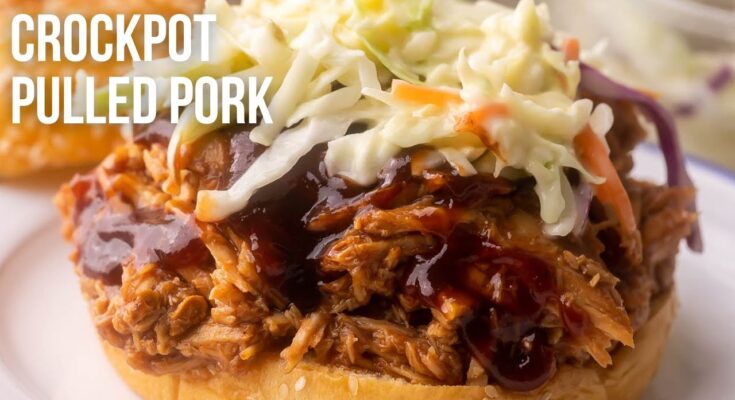Crock Pot Pulled Pork Recipe: If there’s one dish that never fails to impress a crowd and barely asks for your time, it’s crock pot pulled pork. This recipe transforms a humble cut of meat into mouthwatering, fall-apart tender pork that you can use in sandwiches, tacos, salads, or just eat straight out of the pot. It’s a dish that screams comfort food, yet it’s incredibly easy to pull off.
The magic lies in the crock pot. Unlike traditional oven roasts or stovetop braises, the slow cooker does all the heavy lifting. You just set it, forget it, and go about your day while the pork simmers in its juices, soaking up every bit of spice and seasoning. By the time you’re ready to eat, the meat is so tender it practically shreds itself.
Pulled pork is versatile, crowd-pleasing, and wallet-friendly. Whether you’re meal prepping for the week or feeding a group at a casual get-together, it always delivers. Plus, the leftovers? Even better the next day.
Benefits of Slow Cooking Pulled Pork
So why use a crock pot over other cooking methods? For starters, the slow cooking process allows the meat to cook evenly and absorb flavors deeply. When you’re cooking pork low and slow, all that connective tissue and fat slowly melt, making the meat juicy, tender, and packed with flavor.
Another big win is the convenience. You can toss the ingredients in the morning, set the timer, and come home to a house that smells like a BBQ pit. There’s no babysitting the stove, no flipping or basting—just let the crock pot work its magic.
It also makes meal planning a breeze. You can easily double the recipe, store leftovers, and repurpose them into sandwiches, nachos, bowls, or quesadillas throughout the week.
Ingredients You’ll Need
Selecting the Right Cut of Pork
The key to any pulled pork recipe is starting with the right cut of meat. The most commonly used—and best—cut is pork shoulder, also known as pork butt or Boston butt. This cut has the perfect balance of fat and connective tissue, which breaks down during slow cooking to give you that irresistibly tender texture.
Avoid lean cuts like pork loin or tenderloin for this recipe. They tend to dry out during the long cooking time and won’t give you the same juicy results.
If you’re feeding a crowd, aim for 4 to 6 pounds of pork shoulder. Bone-in or boneless both work, but bone-in tends to have a bit more flavor. Just keep in mind it might take a little longer to cook.
Key Spices and Seasonings
What really sets a pulled pork recipe apart is the seasoning. Here’s a simple yet flavorful spice mix you can start with:
- 2 tablespoons brown sugar
- 1 tablespoon paprika
- 2 teaspoons salt
- 1 teaspoon black pepper
- 1 teaspoon garlic powder
- 1 teaspoon onion powder
- 1/2 teaspoon cayenne pepper (optional for a bit of heat)
- 1 teaspoon mustard powder (for tang)
These spices work together to create a savory, slightly smoky rub that gives the pork a deep, rich flavor. If you’re short on time, you can also use a store-bought BBQ rub.
Optional Add-Ons for Extra Flavor
Want to kick it up a notch? Try adding these extras:
- Liquid smoke: A few drops give that signature smoky BBQ flavor without needing a smoker.
- BBQ sauce: You can cook the pork with a cup of your favorite BBQ sauce or add it afterward for a saucier finish.
- Onions and garlic: Layer sliced onions and garlic cloves at the bottom of the crock pot for extra depth.
- Apple cider vinegar: Just a splash helps balance the richness of the pork and brightens the flavor.
Preparing Your Pork
Trimming and Cleaning
Before you get cooking, take a few minutes to prep your pork shoulder. If it has a thick layer of fat on one side, trim it down to about a quarter-inch. You want enough fat for flavor, but not so much that it ends up greasy.
Rinse the pork under cold water and pat it dry with paper towels. This helps the rub stick better and ensures you get a nice crust as it cooks.
If your cut has a bone, no need to remove it—it’ll slide right out after slow cooking. Just be sure to check for any large pieces of excess fat or silver skin that won’t break down in the crock pot.
Seasoning the Meat
Now it’s time to get your hands dirty. Generously coat the pork with the dry rub, making sure to get it into every nook and cranny. Massage it into the meat so the flavors really penetrate.
If you have the time, let it marinate in the fridge for a few hours or overnight. This isn’t required, but it can take the flavor to the next level.
When you’re ready to cook, you can either sear the pork in a hot skillet for a couple of minutes on each side (to lock in flavor and add a bit of texture) or skip this step if you’re in a hurry. Either way, it’s going to turn out delicious.
The Slow Cooking Process
Setting Up Your Crock Pot
Place your pork shoulder in the crock pot, fat side up. This way, the fat renders down over the meat as it cooks, adding moisture and flavor.
If you’re using onions, garlic, or other aromatics, layer them under the pork so they infuse the meat from below. Add about 1/2 to 1 cup of liquid—this could be water, chicken broth, or apple cider vinegar. You don’t want to submerge the pork, just give it a little moisture to start the cooking process.
Cooking Time and Temperature
Set your crock pot to LOW and cook the pork for 8–10 hours, depending on the size of your cut. Cooking on HIGH is an option if you’re short on time, but low and slow always gives better results.
You’ll know the pork is done when it’s so tender that you can shred it with a fork. If it’s not falling apart easily, it needs more time. Don’t rush it—this is a dish that rewards patience.
Tips for Maximum Tenderness
- Don’t lift the lid too often. Every time you open the crock pot, you let out heat and moisture, which can mess with the cooking process.
- Let the pork rest for 15–20 minutes after cooking. This helps the juices redistribute throughout the meat.
- If you want extra flavor, mix the shredded pork with some of the cooking juices before serving.
Shredding and Serving Pulled Pork
Best Methods for Shredding
Once your pork has finished its slow-cooked journey and the meat is tender and juicy, it’s time to shred it. This step is where the magic truly happens—the transformation from a solid hunk of meat to that iconic pulled pork texture.
Start by removing the pork from the crock pot and placing it on a large cutting board or tray. Let it rest for about 10 to 15 minutes to allow the juices to settle. If you skip this, you risk losing a lot of the flavor when you start shredding.
To shred the pork, you can use:
- Two forks: The traditional method. Hold the meat with one fork and pull apart with the other.
- Shredder claws: These handy kitchen tools look like bear claws and make quick work of large amounts of pork.
- Stand mixer: If you’ve got a lot to shred, this is a game-changer. Just drop the pork into the bowl, attach the paddle, and mix on low for 30–60 seconds.
As you shred, discard any large chunks of fat or bone. Some people like to remove all the fat, while others mix in a bit for added flavor and moisture—it’s up to you.
You can return the shredded pork to the crock pot and stir it into the cooking juices to keep it warm and moist, or transfer it to a separate container if you’re adding sauce separately.
Serving Suggestions and Pairings
Pulled pork is incredibly versatile, which is one reason why it’s a go-to for parties, potlucks, and weeknight dinners alike. Here are some delicious ways to serve it:
- Classic Sandwiches: Pile high on toasted buns, drizzle with your favorite BBQ sauce, and add coleslaw for crunch.
- Pulled Pork Tacos: Load it into soft tortillas with fresh pico de gallo, avocado, and a squeeze of lime.
- Pulled Pork Nachos: Layer over tortilla chips with melted cheese, jalapeños, sour cream, and salsa.
- Pulled Pork Bowls: Serve over rice or mashed potatoes with roasted veggies for a hearty meal.
- Pulled Pork Pizza: Yes, really—spread BBQ sauce on a crust, top with pulled pork, red onions, and mozzarella.
Pair it with sides like baked beans, corn on the cob, mac and cheese, or potato salad. And don’t forget the pickles—they cut through the richness of the pork beautifully.
If you’re hosting, set up a DIY pulled pork bar where guests can build their own sandwiches or tacos. It’s fun, customizable, and super easy to prep.
Storing and Reheating Leftovers
How to Store Pulled Pork Properly
Got leftovers? Lucky you! Pulled pork stores like a champ and often tastes even better the next day. Here’s how to store it properly to keep all that flavor locked in:
- Cool it down: Let the pork cool to room temperature before refrigerating. You don’t want to trap steam in the container.
- Add moisture: Mix in a few tablespoons of the cooking juices or BBQ sauce to keep the pork from drying out.
- Use airtight containers: Store the pork in glass or plastic containers with tight lids. You can also use zip-top freezer bags if you’re short on space.
- Refrigeration: Pulled pork will stay good in the fridge for up to 4 days.
- Freezing: Want to save it longer? Freeze it! Portion it out and freeze in airtight containers or bags for up to 3 months.
Label your containers with the date so you don’t forget when you made it. When you’re ready to reheat, it’s still going to be delicious.
Best Ways to Reheat Without Drying Out
Reheating pulled pork the right way is crucial—no one wants dry, rubbery leftovers. Here are the best methods to bring it back to life:
- Stovetop: Add a splash of water, broth, or BBQ sauce to a skillet, then warm the pork over medium heat, stirring occasionally.
- Oven: Cover the pork with foil and bake at 300°F for 20–30 minutes. Add some moisture before covering.
- Microwave: This is the fastest, but be cautious. Cover the pork with a damp paper towel and microwave in short bursts, stirring in between.
- Crock Pot: For larger batches, just return it to the slow cooker on low heat until warmed through.
No matter the method, the key is to reheat it slowly with moisture. That keeps it tender and juicy—just like the first day.
Making Pulled Pork Ahead of Time
Meal Prepping With Pulled Pork
Planning meals ahead? Pulled pork is a meal prep superstar. You can make a big batch over the weekend and enjoy it in different ways throughout the week.
Here’s how to use your pulled pork over 5 days:
- Day 1 – Sandwiches: Classic pulled pork with coleslaw on buns.
- Day 2 – Rice Bowls: Add to a bowl of rice with beans, corn, salsa, and cheese.
- Day 3 – Quesadillas: Stuff into tortillas with cheese and grill until crispy.
- Day 4 – Nachos: Layer on chips with cheese and toppings.
- Day 5 – Salads: Toss over greens with vinaigrette, avocado, and crispy onions.
Pulled pork freezes beautifully too, so if you get tired of it, just freeze a portion for later. You’ll thank yourself on a busy weeknight.
Hosting Tips for a Crowd
If you’re making pulled pork for a party or potluck, here are a few tips to keep things smooth:
- Cook in advance: Make it the day before and reheat in the crock pot before serving.
- Double up: For large groups, use two crock pots or a bigger pork shoulder.
- Serve buffet-style: Set out buns, sauces, and toppings so guests can build their own plates.
- Keep it warm: Use the crock pot’s “warm” setting to keep the pork hot throughout the event.
People will go crazy for it—and you won’t be stuck in the kitchen all night.
Choosing the Best BBQ Sauce
Homemade vs. Store-Bought Options
Let’s talk sauce—it’s the finishing touch that ties the whole pulled pork experience together. Whether you like it tangy, sweet, smoky, or spicy, the right BBQ sauce can take your dish to the next level.
Store-bought sauces are convenient and there’s a wide range of flavors to choose from:
- Sweet and smoky: Great for traditional pulled pork sandwiches.
- Spicy or chipotle-based: Perfect for tacos and nachos.
- Vinegar-based (Carolina-style): Pairs beautifully with fatty pork, cutting through the richness.
- Mustard-based: A bold choice that adds a zesty kick.
When buying a sauce, look at the ingredients. Avoid ones with too much high fructose corn syrup, and go for options with natural sugars and spices.
But if you’re feeling adventurous, why not make your own BBQ sauce? It’s easier than you think. Here’s a simple homemade version:
Quick Homemade BBQ Sauce:
- 1 cup ketchup
- 1/4 cup apple cider vinegar
- 1/4 cup brown sugar
- 1 tablespoon Worcestershire sauce
- 1 tablespoon mustard
- 1 teaspoon smoked paprika
- Salt and pepper to taste
Simmer all ingredients in a saucepan for 10–15 minutes, stirring occasionally. That’s it! You’ve got a sweet, tangy, customizable sauce that’s perfect for your pulled pork.
Pro tip: Serve the sauce on the side rather than mixing it into the whole batch. That way, everyone can choose how saucy they want their plate.
Healthier Alternatives and Modifications
Low-Carb, Gluten-Free, and Keto-Friendly Options
Pulled pork is naturally rich and hearty, but with a few tweaks, you can make it fit just about any dietary plan. Here’s how to adapt the recipe:
Low-Carb/Keto Modifications:
- Skip the sugar in your rub and sauce—use low-carb sweeteners like erythritol or monk fruit.
- Pair with cauliflower rice, lettuce wraps, or keto buns.
- Avoid sugary store-bought sauces; go for homemade versions without added sugars.
Gluten-Free Options:
- Double-check your spices and sauces to make sure they’re gluten-free.
- Use gluten-free buns or serve the pork over potatoes or salads.
- Some Worcestershire sauces contain gluten, so read the label carefully.
Low-Fat/Heart-Healthy Tips:
- Trim excess fat from the pork shoulder.
- Use a leaner cut like pork loin—but reduce cooking time to avoid dryness.
- Pair with veggies or whole grains like quinoa for a balanced meal.
These adjustments let you enjoy all the smoky, savory goodness of pulled pork without compromising your health goals.
Common Mistakes to Avoid
What to Watch Out for When Making Pulled Pork
Even though crock pot pulled pork is pretty foolproof, a few common mistakes can mess up your meal. Here’s what to avoid:
- Using the wrong cut: Lean cuts like tenderloin get dry. Stick with pork shoulder or Boston butt.
- Not seasoning enough: Be generous with your spice rub! It’s what gives the pork its signature flavor.
- Skipping the liquid: Even a small amount of broth or vinegar helps keep the pork moist and flavorful.
- Overcooking on high: Don’t rush it. Low and slow is the name of the game here.
- Not shredding properly: Let it rest before shredding, and use the right tools. Shred into larger chunks for texture.
- Drowning it in sauce: Pulled pork should shine on its own. Let people add sauce to taste.
Avoiding these pitfalls will help you nail the perfect pulled pork every single time.
Pulled Pork Variations Around the World
Regional Twists on a Classic Dish
Pulled pork may feel like an all-American dish, but it’s inspired by slow-cooked meats from around the world. Here are some regional and international takes you might love:
- North Carolina Pulled Pork: Uses a vinegar-based sauce, tangy and spicy.
- South Carolina Style: Mustard-based “Carolina gold” BBQ sauce, zesty and unique.
- Texas-Style Pulled Pork: Rub-heavy, often served dry with sauce on the side.
- Hawaiian Kalua Pork: Cooked with sea salt and liquid smoke, often served with cabbage and rice.
- Mexican Carnitas: Slow-cooked pork with orange juice, then crisped up in a skillet for tacos.
Trying these different styles can keep pulled pork exciting. You could even do a themed pulled pork night and serve up several variations with different sides and sauces.
FAQs about Creamy Mashed Potatoes Recipe
Q1: What are the best potatoes to use for creamy mashed potatoes?
The best potatoes for creamy mashed potatoes are Yukon Gold or Russet potatoes. They’re starchy and break down easily, giving you that fluffy, smooth texture we all crave.
Q2: Can I make mashed potatoes ahead of time?
Yes, absolutely! You can make them a day ahead. Just store them in an airtight container in the fridge and reheat with a splash of milk or cream to restore the creaminess.
Q3: How do I avoid gluey mashed potatoes?
Over-mixing is the enemy here. Use a hand masher or ricer instead of a blender or food processor. Mix just until smooth — no more.
Q4: What can I use instead of heavy cream?
You can substitute with milk, half-and-half, sour cream, or even Greek yogurt for a lighter version. Each adds a slightly different flavor twist.
Q5: Are mashed potatoes gluten-free?
Yes, plain mashed potatoes made with basic ingredients (potatoes, butter, milk, salt) are naturally gluten-free. Just watch for any added thickeners or seasonings.
Q6: Can I freeze mashed potatoes?
Yes! Let them cool, portion into freezer-safe bags or containers, and freeze. Thaw in the fridge overnight and reheat gently, stirring in a little cream or butter.
Q7: How can I make mashed potatoes more flavorful?
Try adding roasted garlic, parmesan cheese, herbs like chives or rosemary, or even a splash of truffle oil for gourmet flair.
Conclusion
There you have it—the ultimate guide to making the most tender, flavorful crock pot pulled pork ever. Whether you’re cooking for a hungry family, prepping meals for the week, or feeding a crowd at your next get-together, this recipe is guaranteed to hit the spot.
It’s the kind of dish that feels like a hug in food form. The slow cooking process builds layers of flavor and texture that you just can’t rush. And best of all? It’s practically hands-off.
Now that you know the secrets to perfect pulled pork—from picking the right cut to shredding, storing, and serving—it’s time to fire up that crock pot and let the slow-cooked magic begin.
Bon appétit, and don’t forget to save those leftovers—you’ll be dreaming about them tomorrow.



